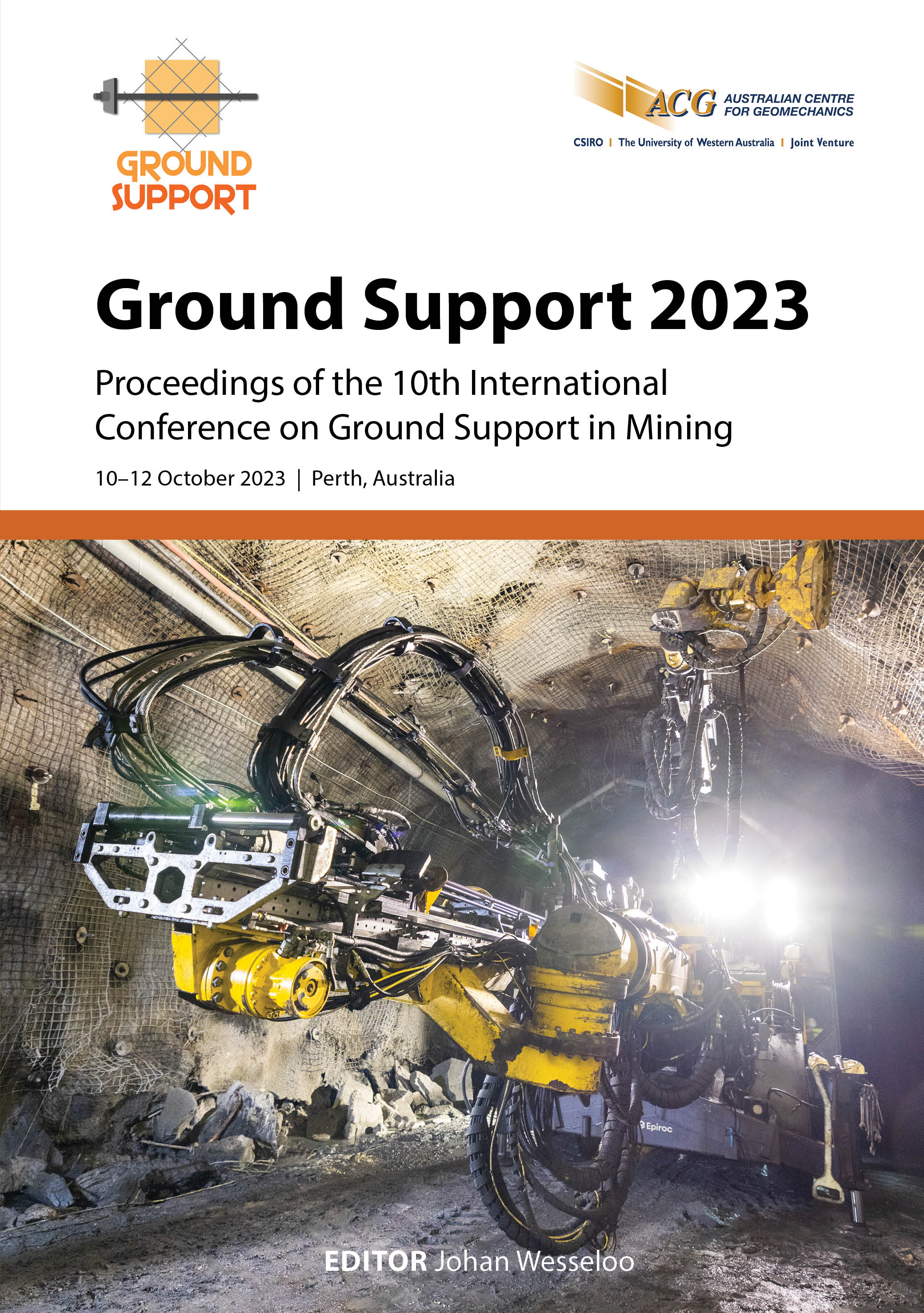Empirical charting for dynamic ground support at Flying Fox and Spotted Quoll mines

|
Authors: Graham, J; Waheed, U; Mikula, PA |
DOI https://doi.org/10.36487/ACG_repo/2325_07
Cite As:
Graham, J, Waheed, U & Mikula, PA 2023, 'Empirical charting for dynamic ground support at Flying Fox and Spotted Quoll mines', in J Wesseloo (ed.), Ground Support 2023: Proceedings of the 10th International Conference on Ground Support in Mining, Australian Centre for Geomechanics, Perth, pp. 115-128, https://doi.org/10.36487/ACG_repo/2325_07
Abstract:
Empirical charting of ground support performance in dynamic conditions using easily available mine site data is a method applied at Flying Fox and Spotted Quoll nickel mines in Western Australia. The focus is on identifying the limiting largest seismic event magnitude for which a given ground support scheme would be expected to sustain damage to a tolerable level. The method has been used previously with success at Long Shaft and Hamlet mines to guide the selection of support in dynamic conditions. Charting defines the relationships between three easily determined factors: the dynamic disturbance (via the seismic event magnitude); the level of ground support damage caused; and the type of installed ground support. Most Flying Fox and Spotted Quoll events are crush events, for which the use of magnitude as a proxy for the dynamic disturbance is suitable. At the mines, installed ground support is broadly classified into three schemes: conventional friction bolt and mesh; fibrecrete with mesh and bolts; and custom high-performance seismic. At Flying Fox mine, 224 data points were available for the preparation of charts for these schemes, while at Spotted Quoll there were 137 data points. Events as large as ML2.2 at Flying Fox and ML2.9 at Spotted Quoll were recorded. Despite the two mines being only 6 km apart, their geomechanical environments were different and a corresponding difference in the empirical charts was evident. Strong advantages of the empirical approach are recognition of the site-installed bolts, seismicity, geology and support performance. This makes the results calibrated to the mine. The approach does not require estimation of ground motion or site effect (for crush-type events) at the precise location of a support element, nor estimation of energy and load capacities of elements during dynamic disturbances. However, the approach has limitations as described in the paper, and the charts are not transferable between mine sites. Empirical charting should provide site engineers with a defensible support selection method for seismic conditions described by an expected or forecast upper event magnitude. The process is simple, transparent and attractive in that it takes into account all of the factors that can negatively impact the actual capacities versus design capacities. It is hoped that the descriptions in this paper will encourage engineers to explore similar work for their sites.
Keywords: ground support system, ground support scheme, dynamic, support selection, support performance, seismicity, empirical chart, mining
References:
Ben-Zion, Y & Zhu, L 2002, ‘Potency-magnitude scaling relations for southern California earthquakes with 1.0<ML<7.0’, Geophysical Journal International, vol. 148, pp. F1–F5.
Kaiser, PK, McCreath, DR & Tannant, DD 1995, Canadian Rockburst Support Handbook, Geomechanics Research Centre, Laurentian University, Sudbury.
Malovichko, D, & Rigby, A 2022, ‘Description of seismic sources in underground mines: dynamic stress fracturing around tunnels and strainbursting’,
Mikula, PA 2012, ‘Progress with empirical performance charting for confident selection of ground support in seismic conditions’,
in Y Potvin (ed.), Deep Mining 2012: Proceedings of the Sixth International Seminar on Deep and High Stress Mining, Australian Centre for Geomechanics, Perth, pp. 71–89,
Mikula, P & Gebremedhin, B 2017, ‘Empirical selection of ground support for dynamic conditions using charting of support performance at Hamlet mine’, in J Wesseloo (ed.), Deep Mining 2017: Proceedings of the Eighth International Conference on Deep and High Stress Mining, Australian Centre for Geomechanics, Perth, pp. 625–636,
/ACG_rep/1704_42_Mikula
© Copyright 2025, Australian Centre for Geomechanics (ACG), The University of Western Australia. All rights reserved.
View copyright/legal information
Please direct any queries or error reports to repository-acg@uwa.edu.au
View copyright/legal information
Please direct any queries or error reports to repository-acg@uwa.edu.au
